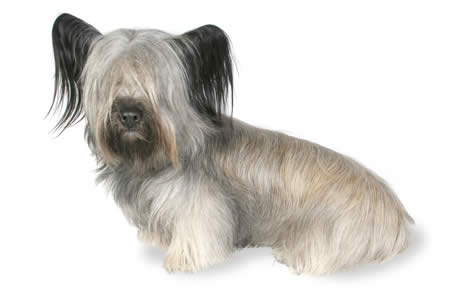The Skye Terrier is a medium-size dog breed developed on the Isle of Skye in Scotland. They were originally bred to hunt and kill badger, otter, and fox, but these days they’re appreciated as a versatile companion breed.
Although these are purebred dogs, you may still find them in shelters and rescues. Remember to adopt! Don’t shop if this is the breed for you.
These dogs are friendly to just about any human they meet, though they have a tendency to be a little shy. Early socialization can help them open up a bit, though they may still prefer a relaxed environment without too many young, rowdy children. Good for novice pet parents, the Skye Terrier can adapt well to apartment life, but they won’t enjoy being left home alone for long hours of the day. Give your pup a bit of exercise and playtime, and you’ll have a friend for life!
DogTime recommends this dog bed to give a good night’s sleep to your medium-sized Skye Terrier. You should also pick up this dog brush and massager for your long-haired pup!
See below for complete list of Skye Terrier dog breed facts and traits!
Skye Terrier Dog Breed Pictures
Adaptability
-
Adapts Well To Apartment Living
Looking for the best dog for your apartment? Contrary to popular belief, the suitability of dogs who adapt well to apartment living goes beyond its size. Apartment dwellers have a myriad of dog breeds to choose from as potential companions, with various factors to consider. Some large breeds can adapt well to apartment living and have lower activity levels. Others may require more space and possess higher energy levels. On the other hand, certain small dog breeds with abundant energy can still find contentment with indoor playtime or brisk walks.
However, when selecting a dog that adapts well apartments, it is essential to prioritize your neighbors. Opting for a pet that doesn’t excessively bark and behaves politely when encountering others in shared spaces like is crucial for maintaining a harmonious apartment environment.
In high-rise settings, it’s worth noting that numerous small dogs may exhibit a propensity for high energy and frequent barking. This makes them less suitable for apartment living. Therefore, desirable qualities in an apartment dog encompass being quiet, low-energy, and displaying polite behavior towards other residents.
Factors To Consider When Choosing A Dog For An Apartment
When considering dogs that adapt well to apartments, size alone should not be the sole determinant. Apartment dwellers have a wealth of dog breeds to choose from as potential furry companions. It’s important to remember that the size of your living space is just one factor to consider. While some larger breeds can adapt well to apartment living, with lower, others may require more space and have higher energy levels, making them less suitable for smaller apartments. Conversely, certain small dog breeds with higher energy levels can still thrive in apartments, finding contentment through indoor playtime or brisk walks. However, it is crucial to consider your neighbors’ comfort when selecting a dog. Opt for a pet that doesn’t bark excessively and behaves politely when interacting with others in shared spaces.
Therefore, it’s important to prioritize qualities such as being quiet, low-energy, calm indoors, and exhibiting good manners when living in close proximity to other residents. By considering these factors, you can find a dog that will adapt well to apartment living and create a harmonious living environment for everyone involved.
-
Good For Novice Owners
Some dogs are simply easier than others; they take to training better and are fairly easygoing. They’re also resilient enough to bounce back from your mistakes or inconsistencies.
Dogs who are highly sensitive, independent thinking, or assertive may be harder for a first-time dog parent to manage. You’ll get your best match if you take your dog-owning experience into account as you choose your new pooch.
If you’re new to dog parenting, take a look at 101 Dog Tricks and read up on how to train your dog!
-
Sensitivity Level
Some dogs will let a stern reprimand roll off their backs, while others take even a dirty look to heart. Low-sensitivity dogs, also called “easygoing,” “tolerant,” “resilient,” and even “thick-skinned,” can better handle a noisy, chaotic household, a louder or more assertive owner, and an inconsistent or variable routine. Do you have young kids, throw lots of dinner parties, play in a garage band, or lead a hectic life? Go with a low-sensitivity dog.
-
Tolerates Being Alone
Some breeds bond very closely with their family and are more prone to worry or even panic when left alone by their owner. An anxious dog can be very destructive–barking, whining, chewing, and otherwise causing mayhem. These breeds do best when a family member is home during the day or if you can take the dog to work.
-
Tolerates Cold Weather
Breeds with very short coats and little or no undercoat or body fat, such as Greyhounds, are vulnerable to the cold. Dogs with a low cold tolerance need to live inside in cool climates and should have a jacket or sweater for chilly walks. You can find a great jacket for your dog here!
-
Tolerates Hot Weather
Dogs with thick, double coats are more vulnerable to overheating. So are breeds with short noses, like Bulldogs or Pugs, since they can’t pant as well to cool themselves off. If you want a heat-sensitive breed, your dog will need to stay indoors with you on warm or humid days, and you’ll need to be extra cautious about exercising your dog in the heat.
All-around friendliness
-
Affectionate With Family
When it comes to unconditional love and unwavering loyalty, few animals can rival the affectionate nature of dogs. These remarkable creatures have earned their reputation as man’s best friend, and many breeds are particularly renowned for their love and devotion to their families. With their warm hearts and wagging tails, affectionate family dogs enrich the lives of their owners in countless ways.
One such breed known for its affectionate demeanor is the Golden Retriever. With their gentle temperament and friendly disposition, Golden Retrievers form deep bonds with their families. They eagerly participate in family activities, whether it’s a game of fetch in the yard or cuddling on the couch during a movie night. Their expressive eyes and ever-wagging tails are a testament to the joy they feel in the presence of their loved ones.
Another family-favorite breed is the Labrador Retriever. Renowned for their playful and patient nature, Labradors are excellent companions for children and adults alike. They readily engage in playtime with the kids, showcasing their boundless energy and enthusiasm. But when the day winds down, they seamlessly transition into loving and gentle cuddle buddies, comforting their family members with their warm presence.
Beyond specific breeds, mixed-breed dogs also have a special place in the hearts of families seeking affectionate companions. The shelter dogs, in particular, form deep connections with their adoptive families. They seem to understand the second chance they’ve been given and repay it with endless love and gratitude.
How To Know If A Dog Is Good With Families
The affectionate nature of family dogs extends beyond play and cuddles. Dogs have a remarkable ability to sense their owner’s emotions, offering comfort and support during difficult times. Whether it’s a wagging tail after a long day at work or a sympathetic nuzzle during moments of sadness, they prove time and again that they are attuned to their family’s needs.
It is important to note that not all dogs of the same breed will be equally affectionate. Some dogs may be more independent or aloof, while others may be more clingy or demanding of attention. The best way to find out how affectionate a dog is is to meet them in person and interact with them.
-
Kid-Friendly
Being gentle with children, sturdy enough to handle the heavy-handed pets and hugs they can dish out, and having a blasé attitude toward running, screaming children are all traits that make a kid-friendly dog. You may be surprised by who’s on that list: Fierce-looking Boxers are considered good with children, as are American Staffordshire Terriers (which are considered Pit Bulls). Small, delicate, and potentially snappy dogs such as Chihuahuas aren’t always so family-friendly.
**All dogs are individuals. Our ratings are generalizations, and they’re not a guarantee of how any breed or individual dog will behave. Dogs from any breed can be good with children based on their past experiences, training on how to get along with kids, and personality. No matter what the breed or breed type, all dogs have strong jaws, sharp pointy teeth, and may bite in stressful circumstances. Young children and dogs of any breed should always be supervised by an adult and never left alone together, period.
-
Dog Friendly
Friendliness toward dogs and friendliness toward humans are two completely different things. Some dogs may attack or try to dominate other dogs, even if they’re love-bugs with people; others would rather play than fight; and some will turn tail and run. Breed isn’t the only factor. Dogs who lived with their littermates and mother until at least six to eight weeks of age and who spent lots of time playing with other dogs during puppyhood, are more likely to have good canine social skills.
-
Friendly Toward Strangers
Stranger-friendly dogs will greet guests with wagging tails and nuzzles; others are shy, indifferent, or even aggressive. However, no matter what the breed, a dog who was socialized and exposed to lots of different types, ages, sizes, and shapes of people as a puppy will respond better to strangers as an adult. Remember that even friendly dogs should stay on a good, strong leash like this one in public!
Health And Grooming Needs
-
Amount Of Shedding
If you’re going to share your home with a dog, you’ll need to deal with some level of dog hair on your clothes and in your house. However, shedding does vary greatly among the breeds. Some dogs shed year-round, some “blow” seasonally, some do both, and some shed hardly at all. If you’re a neatnik, you’ll need to either pick a low-shedding breed or relax your standards. To help keep your home a little cleaner, you can find a great de-shedding tool here!
-
Drooling Potential
Drool-prone dogs may drape ropes of slobber on your arm and leave big, wet spots on your clothes when they come over to say hello. If you’ve got a laid-back attitude toward slobber, fine; but if you’re a neatnik, you may want to choose a dog who rates low in the drool department.
-
Easy To Groom
Some breeds are brush-and-go dogs; others require regular bathing, clipping, and other grooming just to stay clean and healthy. Consider whether you have the time and patience for a dog who needs a lot of grooming, or the money to pay someone else to do it.
-
General Health
Due to poor breeding practices, some breeds are prone to certain genetic health problems, such as hip dysplasia. This doesn’t mean that every dog of that breed will develop those diseases; it just means that they’re at an increased risk.
If you’re adopting a puppy, it’s a good idea to find out which genetic illnesses are common to the breed you’re interested in. You may also want to ask if your shelter or rescue has information about the physical health of your potential pup’s parents and other relatives.
-
Potential For Weight Gain
Some breeds have hearty appetites and tend to put on weight easily. As in humans, being overweight can cause health problems in dogs. If you pick a breed that’s prone to packing on pounds, you’ll need to limit treats, make sure they get enough exercise, and measure out their daily food servings into regular meals rather than leaving food out all the time.
Ask your vet about your dog’s diet and what they recommend for feeding your pooch to keep them at a healthy weight. Weight gain can lead to other health issues or worsen problems like arthritis.
-
Size
Get ready to meet the giants of the doggy world! Large dog breeds aren’t just big balls of fluff, they’re like loving, oversized teddy bears on a mission to steal your heart. Need some convincing? Let’s dive into the awesome benefits of owning one!
First things first, these pooches are a living security system! With their impressive size and thunderous barks, they’ll have any would-be intruder running for the hills. Talk about peace of mind! Plus, who needs an alarm when you’ve got a furry giant protecting your castle?
But that’s not all. Large dog breeds are all about loyalty and devotion. They’ll stick by your side through thick and thin, becoming your most dedicated bestie. Their love knows no bounds! When you have a giant fluffball showing you unconditional love, you’ll feel like the luckiest human on the planet.
Now, let’s talk about their talents. These big fellas are the ultimate working partners. With brains and brawn, they’re up for any challenge. From search and rescue missions to lending a helping paw to those in need, these dogs are superheroes in fur coats. They’ll make you proud every step of the way!
Don’t let their size fool you—these gentle giants have hearts as big as their paws. They’re incredible with kids and other pets, spreading their love like confetti. Their patience and kindness make them perfect family pets, ensuring harmony in your household.
Oh, and get ready to break a sweat! These dogs are fitness enthusiasts, and they’ll keep you on your toes. Daily walks, jogs, and play sessions will not only keep them happy and healthy but will also give you a reason to ditch the couch and join in on the fun. It’s a win-win situation!
So, if you’re ready for a dose of big love, go ahead and consider a large dog breed. They’re the best wing-dog you could ever ask for, ready to make your life a thousand times more exciting, loving, and downright awesome! Get ready for the big adventure of a lifetime!
Trainability
-
Easy To Train
Easy-to-train dogs are more adept at forming an association between a prompt (such as the word “sit”), an action (sitting), and a consequence (getting a treat) very quickly. Other dogs need more time, patience, and repetition during training.
Many breeds are intelligent but approach training with a “What’s in it for me?” attitude, in which case you’ll need to use rewards and games to teach them to want to comply with your requests.
Related:
10 Fun, Impressive Tricks You Can Teach Any Dog
-
Intelligence
Dogs who were bred for jobs that require decision making, intelligence, and concentration, such as herding livestock, need to exercise their brains, just as dogs who were bred to run all day need to exercise their bodies. If they don’t get the mental stimulation they need, they’ll make their own work–usually with projects you won’t like, such as digging and chewing. Obedience training and interactive dog toys are good ways to give a dog a brain workout, as are dog sports and careers, such as agility and search and rescue.
-
Potential For Mouthiness
Common in most breeds during puppyhood and in Retriever breeds at all ages, mouthiness means a tendency to nip, chew, and play-bite (a soft, fairly painless bite that doesn’t puncture the skin). Mouthy dogs are more likely to use their mouths to hold or “herd” their human family members, and they need training to learn that it’s fine to gnaw on chew toys, but not on people. Mouthy breeds tend to really enjoy a game of fetch, as well as a good chew on a toy that’s been stuffed with kibble and treats.
-
Prey Drive
Dogs with a high prey drive have an instinctive desire to stalk, capture, and prey upon potential food sources. Dogs who were bred to hunt, such as Terriers, have an inborn desire to chase — and sometimes kill — other animals. Anything whizzing by — such as cats, squirrels, and perhaps even cars — can trigger that instinct.
How to address a high prey drive
Off-leash adventures are too great a temptation for pups who will wander and hunt. Dogs who like to chase need to be leashed. And, even on a leash, you may experience your dog pulling on the leash to reach rodents or birds in their sight. Otherwise, these pups should be kept in a fenced area when outdoors. If your pup has a high prey drive, you’ll need a high, secure fence in your yard.
These breeds generally aren’t a good fit for homes with smaller pets that can look like prey, such as cats, hamsters, or small dogs. Breeds that were originally used for bird hunting, on the other hand, generally won’t chase, but you’ll probably have a hard time getting their attention when there are birds flying by.
Other behavioral concerns
Observing your dog’s prey drive, which is instinctual and biologically-rooted, is not the same as observing aggression. Much aggression is born of fear and anxiety, especially in the case of dog aggression toward humans.
The tendency to wander, even into oncoming traffic, can produce diasterious results for pups with predatory instincts. It can also lead to pups being bitten by snakes or attacked by other wild animals they may pursue while on the hunt.
-
Tendency To Bark Or Howl
Some breeds sound off more often than others. When choosing a breed, think about how often the dog vocalizes. Learn more about breeds with a tendency to bark or howl.
If you’re considering a hound, would you find their trademark howls musical or maddening? If you’re considering a watchdog, will a city full of suspicious “strangers” put your pup on permanent alert? Will the local wildlife literally drive your dog wild? Do you live in housing with noise restrictions? Do you have neighbors nearby? Then you may wish to choose a quieter dog.
-
Wanderlust Potential
Some breeds are more free-spirited than others. Nordic dogs such as Siberian Huskies were bred to range long distances, and given the chance, they’ll take off after anything that catches their interest. And many hounds simply must follow their noses–or that bunny that just ran across the path–even if it means leaving you behind.
Exercise needs
-
Energy Level
High-energy dogs are always ready and waiting for action. Originally bred to perform a canine job of some sort, such as retrieving game for hunters or herding livestock, they have the stamina to put in a full workday. They need a significant amount of exercise and mental stimulation, and they’re more likely to spend time jumping, playing, and investigating any new sights and smells.
Low-energy dogs are the canine equivalent of a couch potato, content to doze the day away. When picking a breed, consider your own activity level and lifestyle, and think about whether you’ll find a frisky, energetic dog invigorating or annoying.
-
Intensity
A vigorous dog may or may not have high energy, but everything they do, they do with vigor: they strain on the leash (until you train them not to), try to plow through obstacles, and even eats and drinks with great big gulps. These dynamos need lots of training to learn good manners, and may not be the best fit for a home with young kids or someone who’s elderly or frail. A low-vigor dog, on the other hand, has a more subdued approach to life.
-
Exercise Needs
Some breeds do fine with a slow evening stroll around the block. Others need daily, vigorous exercise, especially those that were originally bred for physically demanding jobs, like herding or hunting.
Without enough exercise, these breeds may put on weight and vent their pent-up energy in ways you don’t like, such as barking, chewing, and digging. Breeds that need a lot of exercise are good for outdoorsy, active people, or those interested in training their dog to compete in a high-energy dog sport, such as agility.
-
Potential For Playfulness
Some dogs are perpetual puppies — always begging for a game — while others are more serious and sedate. Although a playful pup sounds endearing, consider how many games of fetch or tag you want to play each day, and whether you have kids or other dogs who can stand in as playmates for the dog.
Skye Terrier Overview
Like his fellow terriers, the Skye was created in Great Britain — on the Isle of Skye, one of Scotland’s Inner Hebrides islands, to be exact — to rid farms of den-dwelling creatures whose holes were a hazard to livestock. Distinguished by a lush coat, long body, and gracefully feathered prick or drop ears, the Skye’s versatility enabled him to vanquish vermin and keep company with duchesses, both with equal aplomb.
How did a tough little terrier become a fashionable companion? Queen Victoria, who frequently vacationed in Scotland, was responsible for bringing the breed to public notice. He won further recognition when renowned portrait artist Sir Edwin Landseer featured him in paintings. Soon it was said that a duchess would be almost ashamed to be seen in the park without her Skye Terrier by her side.
The Skye has always been more than a vermin-buster in a fancy coat, however. He’s fearless and self-assured, but he’s also friendly, happy, and devoted to his people. Strangers who wait for him to make the first move will find he accepts them as well — once he’s decided they aren’t pushy or a threat.
He has a mind of his own when it comes to training, but he’s sensitive and responds well to a firm voice and positive-reinforcement techniques that involve food rewards, praise, and play.
Like any self-respecting terrier, the Skye is ready to take on other dogs of any size, and he shouldn’t be left alone with small furry pets such as rabbits, hamsters, guinea pigs, or gerbils. They look a bit too much like lunch.
On the plus side, he’s an excellent watchdog, and more low-key than most terriers. His small size makes him adaptable to any environment, including an apartment or condo — though his barking might annoy the neighbors.
While the Skye isn’t needy, he expects his fair share of your affection and attention, not to mention respect. Neglect him at your peril. The Skye will inform you of your error by digging, chewing, and barking to express his irritation.
The Skye Terrier believes in a give-and-take relationship. If he’s given the respect, affection, and attention he deserves, he will lavish the same on his people. A Skye will always make you laugh, but when you need to cry, he and his long coat will be there to absorb your tears.
Skye Terrier Highlights
- Skye Terriers are best suited to homes with older children who understand how to interact with dogs.
- Skye Terriers need early socialization to people and other animals. They are naturally reserved, and socialization will help prevent shy, timid, or aggressive behaviors.
- The Skye Terrier requires weekly brushing and a bath every two to three weeks. He’s considered an average shedder.
- Skye Terriers can be very destructive if they are bored or are frequently left alone for long periods.
- Although the Skye Terrier has a moderate activity level and is quiet indoors, he still requires daily exercise. Expect at least 30 minutes of exercise each day.
- Skye Terriers can do well in apartments.
- A Skye Terrier needs a fenced yard to prevent him from running after other animals or people who pass by his property.
- Like many of the terrier breeds, Skye Terrier enjoys digging; after all, that’s what he was bred to do.
- The Skye Terrier is a great watchdog.
- Skye Terriers can be aggressive toward dogs they don’t know and will chase and kill smaller pets.
- Skye Terriers respond best to positive training techniques, a firm tone, and consistent expectations. They have a mind of their own and can make training difficult if they choose to.
- Never buy a Skye Terrier from a puppy mill, a pet store, or a breeder who doesn’t provide health clearances or guarantees. Look for a reputable breeder who tests her breeding dogs to make sure they’re free of genetic diseases that they might pass onto the puppies and who breeds for sound temperaments.
Skye Terrier History
The Skye is an old breed of terrier that originated more than four centuries ago on the Isle of Skye in Scotland. He was used to hunt badger, fox, and otter, following them into their burrows and pulling them out to kill them.
To this day, he has remained relatively unchanged, with his short, sturdy legs made for digging and his double coat to protect him from rough brush, thorns, and bites from his adversaries, as well as inclement Scottish weather.
What may have been the first book on dogs, Johannes Caius’ Of English Dogges, written in 1570, describes the Skye Terrier this way: “brought out of barbarous borders fro’ the uttermost countryes northward…which, by reason of the length of heare [hair], makes showe neither of face nor of body.”
Through his description, we know that the breed was already well established at that time. The breed has not always been known as the Skye Terrier. He has also been called the Clydesdale Terrier, the Fancy Skye Terrier, the Silky Skye Terrier, the Glasgow Terrier, and the Paisley Terrier.
Queen Victoria was a fan of the breed and kept and bred Skye Terriers. At one time the Skye Terrier was one of the most popular terrier breeds around.
The Skye Terrier was recognized by the American Kennel Club in 1887, and the first Skye to be registered by the AKC was Romach, that same year. The Skye Terrier Club of America was founded in 1938.
Despite his potential as a companion, the Skye Terrier is a rare breed, ranking 146th among the 155 breeds and varieties registered by the AKC.
Skye Terrier Size
The ideal height for a Skye Terrier is 10 inches for a male and 9.5 inches for a female. Generally a Skye Terrier weighs 25 to 40 pounds.
Skye Terrier Personality
The Skye is brave, good-natured, and loyal to his own family. He doesn’t make friends with just anyone and prefers people to take their time in approaching him. He’s reserved and cautious toward strangers, traits that make him an excellent watchdog.
The Skye has been called canny, a Scottish word with a variety of meanings, all of which can be applied to almost any terrier — prudent, astute, skilled, and steady. He’s sensitive but not submissive with a mind of his own.
He has a long memory and will remember slights or mistreatment. Skyes like to be part of the family and will become bored, wilful, and unhappy if neglected.
Like every dog, Skyes need early socialization — exposure to many different people, sights, sounds, and experiences — when young. Socialization helps ensure that your Skye Terrier puppy grows up to be a well-rounded dog.
Skye Terrier Health
The Skye Terrier is a very healthy breed. The only issue that’s a potential concern is orthopedic problems that could occur during growth. The Skye is achondroplastic, meaning that he has a large body on small legs. If he’s allowed to jump or climb excessively during puppyhood, before the growth plates in his legs have closed, he may limp or develop a condition called premature closure, which occurs when the growth plates don’t close properly. Wait until he’s 18 to 24 months old before taking him on long walks or letting him do any jumping or stair climbing.
Skye Terrier Care
Thanks to his small size and moderate exercise needs, the Skye can adapt to any environment, from apartment to country home. Regardless, he should live indoors with his people.
When outside, he should be in a fenced yard or on leash so he’s protected from traffic and encounters with other dogs, toward whom he’s likely to express some dislike.
The Skye will enjoy a daily walk or active play in the yard. Without regular exercise and training, he’ll become bored and unhappy, which invariably leads to destructive or noisy behavior.
Take some environmental precautions when raising a Skye puppy. The Skye Terrier has bowed front legs, which provide a curve for a deep chest. A young Skye Terrier should never be allowed to climb up stairs, or jump onto or off or furniture. Allowing a Skye Terrier to do these things when he’s young can put unnecessary stress on his front legs.
Train the strong-willed Skye with positive reinforcement techniques, but be firm and consistent in what you require. If your Skye thinks he can get away with disobeying you, he’ll always try.
Skye Terrier Feeding
Recommended daily amount: 1 3/8 to 1 7/8 cups of a high-quality dog food daily, divided into two meals.
How much your adult dog eats depends on his size, age, build, metabolism, and activity level. Dogs are individuals, just like people, and they don’t all need the same amount of food. It almost goes without saying that a highly active dog will need more than a couch potato dog.
The quality of dog food you buy also makes a difference — the better the dog food, the further it will go toward nourishing your dog and the less of it you’ll need to shake into your dog’s bowl.
Keep your Skye Terrier in good shape by measuring his food and feeding him twice a day rather than leaving food out all the time. If you’re unsure whether he’s overweight, give him the eye test and the hands-on test.
First, look down at him. You should be able to see a waist. Then place your hands on his back, thumbs along the spine, with the fingers spread downward. You should be able to feel but not see his ribs without having to press hard. If you can’t, he needs less food and more exercise.
For more on feeding your Skye Terrier, see our guidelines for buying the right food, feeding your puppy, and feeding your adult dog.
Skye Terrier Coat Color And Grooming
The Skye wears an elegant and stylish coat that hangs straight down each side from a part that runs down the back from head to tail. The undercoat is short, soft, and woolly, covered with an outer coat of straight hair with a hard texture.
On the head, Lana Turner bangs veil the forehead and eyes. (Many owners opt to hold the long bangs back with an elastic or barrette.) The Skye also sports a beard and apron (the longer hair on the chest).
The Skye’s coat comes in black, blue, dark or light gray, silver platinum, fawn, or cream. It’s one overall color at the skin, but you may see varying shades of the same color in the full coat. He may also have black points, or markings, on the ears, muzzle, and tail tip. Puppies often have wide variations in coat color until they mature at approximately 18 months of age.
The long and luxurious coat requires weekly brushing with a pin brush or long-toothed comb. A bath every two to three weeks keeps the coat clean. Be sure to brush or comb out any tangles before bathing the dog. Once they get wet, they tighten up and are more difficult to remove. If you’re brushing a dry dog, mist the coat with water as you brush to prevent hair breakage.
Other grooming needs include dental hygiene and nail care. Brush your Skye’s teeth at least two or three times a week to remove tartar buildup and the accompanying bacteria. Daily is better.
Trim his nails once or twice a month, as needed. If you can hear the nail clicking on the floor, they’re too long. Short nails keep the feet in good condition and won’t scratch your legs when your Skye jumps up to greet you.
Begin accustoming your Skye to being brushed and examined when he’s a puppy. Handle his paws frequently — dogs are touchy about their feet — and look inside his mouth and ears.
Make grooming a positive experience filled with praise and rewards, and you’ll lay the groundwork for easy veterinary exams and other handling when he’s an adult.
Skye Terrier Children And Other Pets
A Skye Terrier can make an excellent companion for older children if he’s properly socialized. His terrier temperament may make him too feisty to be a playmate for children younger than six years old, however.
Always teach children how to approach and touch dogs, and always supervise any interactions between dogs and young children to prevent any biting or ear or tail pulling on the part of either party. Teach your child never to approach any dog while he’s sleeping or eating or to try to take the dog’s food away. No dog, no matter how good-natured, should ever be left unsupervised with a child.
The Skye Terrier can be aggressive toward dogs he doesn’t know, but he should get along well with dogs and cats he’s raised with. He’s not recommended for homes with smaller pets since he may view them as a tasty snack.
Skye Terrier Rescue Groups
Before contacting a breeder, consider going to a Skye Terrier rescue group.
Skye Terrier Dog Breed Pictures
-
Skye Terrier Dog Breed Picture

-
Skye Terrier Dog Breed Picture
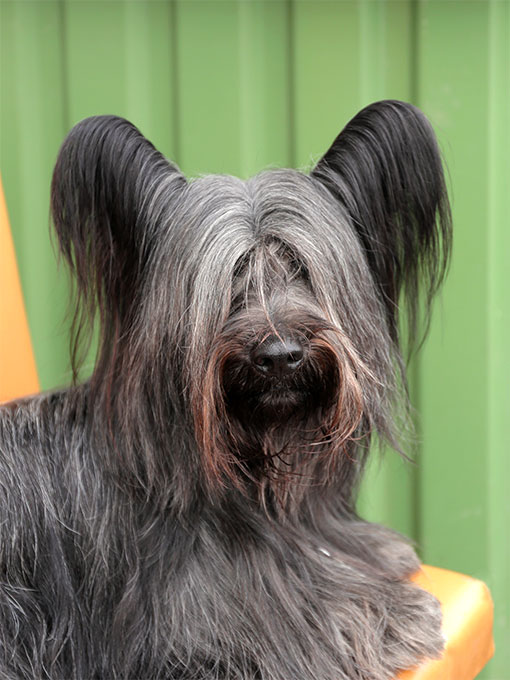
-
Skye Terrier Dog Breed Picture

-
Skye Terrier Dog Breed Picture
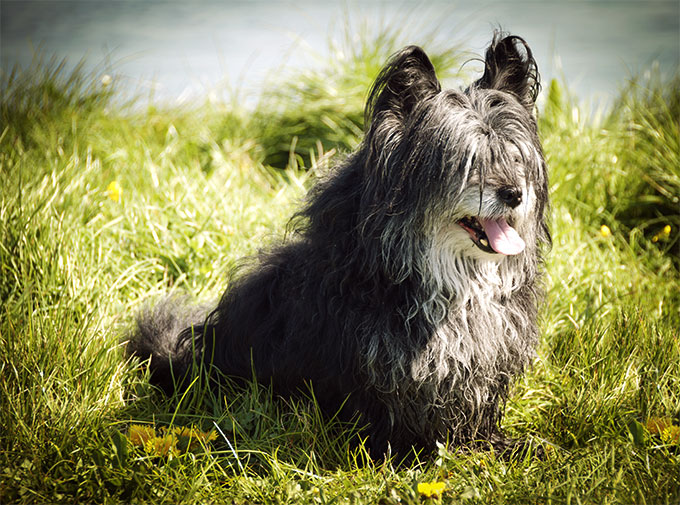
-
Skye Terrier Dog Breed Picture
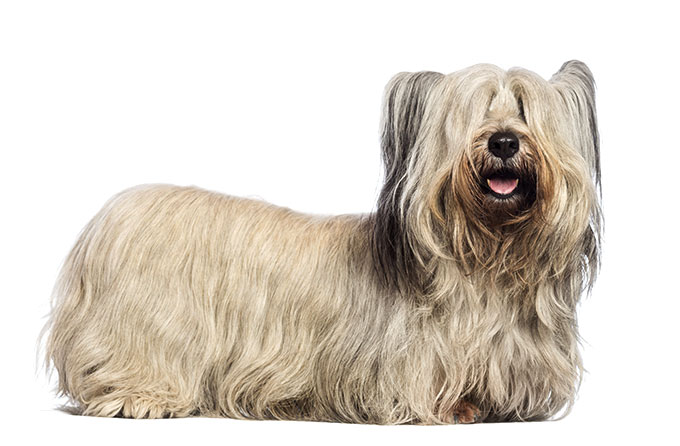
-
Skye Terrier Dog Breed Picture
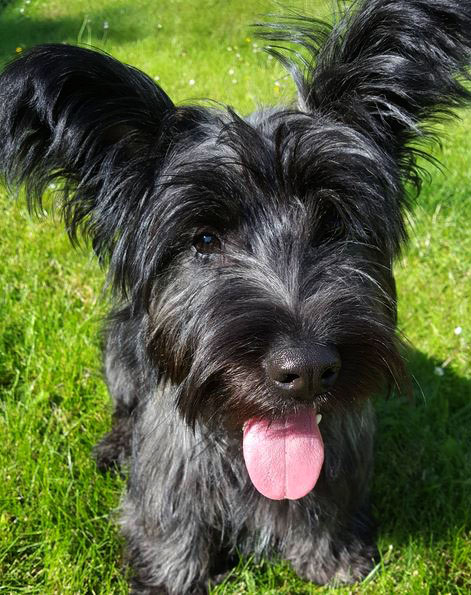
-
Skye Terrier Dog Breed Picture

-
Skye Terrier Dog Breed Picture
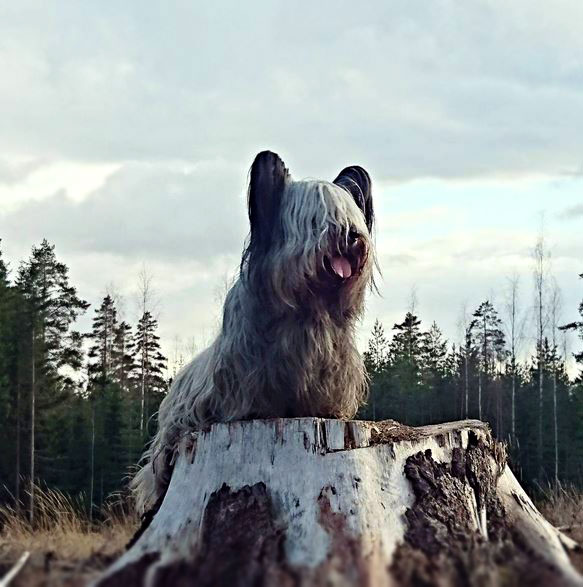
-
Skye Terrier Dog Breed Picture
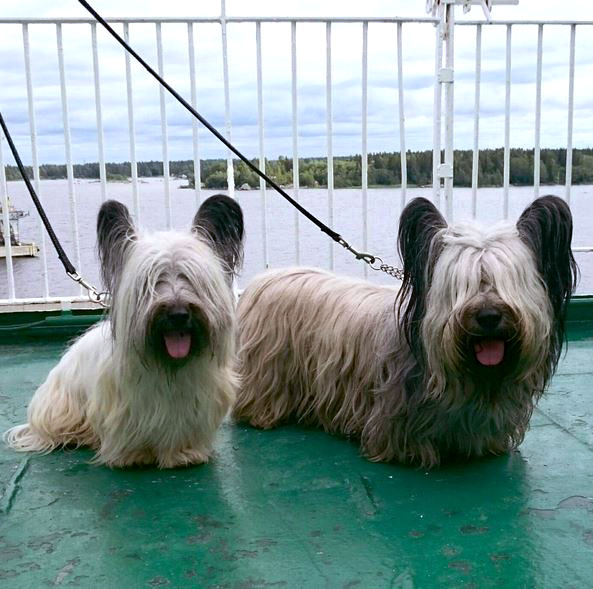
-
Skye Terrier Dog Breed Picture

